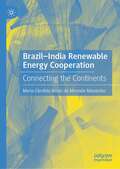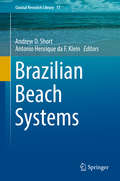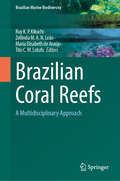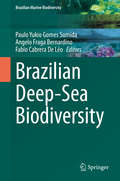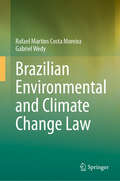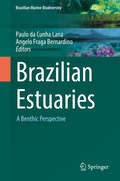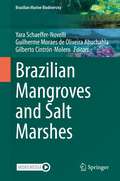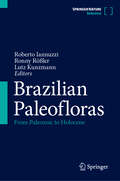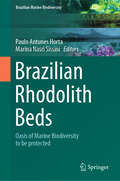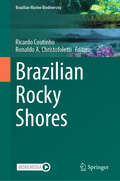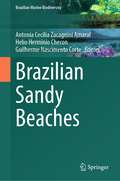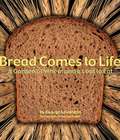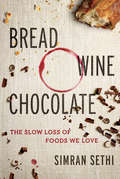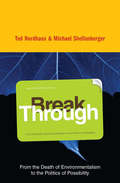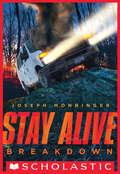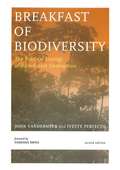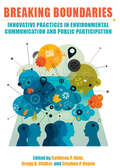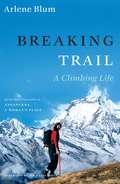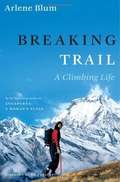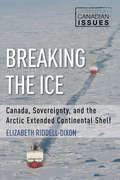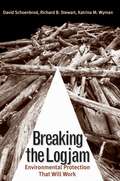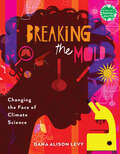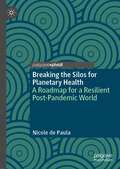- Table View
- List View
Brazil-India Renewable Energy Cooperation: Connecting the Continents
by Maria Cândida Arrais de Miranda MousinhoThe book is a study of the cooperation of Brazil and India on renewable energy. It is based on a research project on the energy sector of both the countries. It discusses the agreements in the energy sector between the two countries and the renewable energy policies developed in four decades. A scientific and technological mapping, a brief study of competitiveness and a primary research were carried out in order to find out the weaknesses and the opportunities for cooperation in renewable energies. This Publication will undoubtedly provoke the reader to reflect on the importance of cooperation given the growing protectionism not only in terms of energy security, but also in terms of investments in new technologies considering energy transition scenario. For Brazil and India, intensifying the dialogue is more than a strategy of visibility and the search for greater space in worldwide geopolitics.
Brazilian Beach Systems (Coastal Research Library #17)
by Andrew D. Short Antonio Henrique da F. KleinThis book is about the more than 4,000 beach systems that form most of the 9000 km long Brazilian coast. It focuses on the beaches of each of the seventeen coastal states and three oceanic islands, their nature, morphodynamics and status. It is a must for anyone who wants to know more about this great coast and its beach systems. This is the first book ever written about the beach systems of Brazil, and actually the very first about the beaches of an entire country. The Brazilian coast extends from the mighty Amazon River and its muddy shores in the north to one of the world's longest sandy beaches in the southern Rio Grande do Sul. It contains every beach type from wave to tide-dominated which range in size from small embayed beaches to long barrier beaches. The book is written by leading Brazilian academics and researchers and aims at the university level market, as well as coastal scientists, engineers and managers. Standard scientific terminology is used to describe the coast and its beaches. It is illustrated with more than 400 original figures and serves as a benchmark text on the Brazilian coast.
Brazilian Coral Reefs: A Multidisciplinary Approach (Brazilian Marine Biodiversity)
by Ruy K. P. Kikuchi Maria Elisabeth de Araújo Zelinda M. A. N. Leão Tito M. C. LotufoThe Brazilian coral reefs form structures significantly different from the well-known reef models, as follows: they have a growth form of mushroom-shaped coral pinnacles called "chapeirões"; they are built by a low diversity coral fauna rich in endemic species, with most of them relic forms dating back to the Miocene; and the nearshore bank reefs are surrounded by siliciclastic sediments. The reefs are distributed into four major sectors along the Brazilian coast: the northern, the northeastern, and the eastern regions, and the oceanic islands, but certain isolated coral species can be found in warmer waters in the embayment of the southern region. There are different types of bank reefs, fringing reefs, isolated "chapeirões" and an atoll present along the Brazilian coast. Corals, milleporids, and coralline algae build the rigid frame of the reefs. The areas in which the major coral reefs occur correspond to regions in which nearby urban centers are experiencing accelerated growth, and tourism development is rapidly increasing. The major human effects on the reef ecosystem are mostly associated with the increased sedimentation due to the removal of the Atlantic rainforest and the disposal of industrial and urban effluents. Fishing resources are seriously declining due to pollution and overfishing, and this reduction impacts artisanal fishers, who are impoverished and face food security risks. The effects of warming oceanic waters that have been affecting several reef areas with high-intensity coral bleaching did not show until the 2010 event, episodes of coral mass mortality in Brazilian reefs. However, since 2016, bleaching has increased, as has the mortality of milleporids. There are opportunities to develop purposeful biotechnologies that can support coral reef restoration and conservation. Reciprocally, preserved coral reef ecosystems containing peculiar genetic resources allow biotechnological opportunities to provide products and processes for economically and ecologically prosperous societies.
Brazilian Deep-Sea Biodiversity (Brazilian Marine Biodiversity)
by Angelo Fraga Bernardino Paulo Yukio Gomes Sumida Fabio Cabrera De LéoThis book presents the biodiversity of the Brazilian deep-sea and its many unique geological and biological features, as well as a review of its ecology, conservation, and future research needs. The deep-sea Brazilian margin has an incredible geological heterogeneity with numerous characteristic seafloor features, and latitudinal changes in marine productivity, oceanographic conditions and biological communities have resulted in very distinct biological assemblages at regional and bathymetric scales. It is a tremendously rich ecosystem in terms of living species, from which many well-known historical tales have originated, and with unique importance for the global climate and humanity. Nevertheless, vast areas of the Brazilian margin have been explored for fishing, oil and gas, and other commodities, likely impacting a variety of deep-sea habitats at scales and intensities yet undetermined. This book is intended for students, scholars, professionals and a wide audience interested in the deep-sea in general and, more specifically, in the South Atlantic deep-sea.
Brazilian Environmental and Climate Change Law
by Rafael Martins Costa Moreira Gabriel WedyThe book covers a range of topics including the historical evolution and present landscape of Brazilian environmental law; fundamental principles of environmental law; environmental constitutionalism in Brazil; the legal framework governing environmental assets; animal protection and rights; environmental federalism; national environmental policy; administrative tools for environmental regulation; civil and criminal environmental liability; judicial interpretations of environmental law; specially protected areas; climate change legislation and litigation; and water resource management. This book is intended for those interested in Brazilian environmental and climate change law, specifically catering to students, lawyers, jurists, scholars, and anyone eager to grasp the key aspects and current status of this field. With the international focus on Brazil as a 'continental Country' and the limited availability of English literature on the subject, compounded by the challenges many non-Portuguese speaking academics encounter, this book serves as a comprehensive resource for understanding how Brazil's legal and justice systems address environmental issues.
Brazilian Estuaries: A Benthic Perspective (Brazilian Marine Biodiversity)
by Paulo Da Lana Angelo Fraga BernardinoThis book presents the main drivers of benthic structure and processes in estuaries from the 8,000 km-Brazilian coast, assesses the influence of natural and human disturbance, and discusses their ecological importance and management needs. Estuaries are unique coastal ecosystems often with low biodiversity that sustain and provide essential ecological services to mankind. These ecosystems include a variety of habitats with their own sediment and fauna dynamics, all of them globally altered or threatened by human activities. Mangroves, saltmarshes, tidal flats and other confined estuarine systems are under increasing stress by overfishing and other human activities leading to habitat and species loss. Combined changes in estuarine hydromorphology and in climate pose severe threats to estuarine ecosystems at a global scale.
Brazilian Mangroves and Salt Marshes (Brazilian Marine Biodiversity)
by Yara Schaeffer-Novelli Guilherme Moraes de Oliveira Abuchahla Gilberto Cintrón-MoleroThis book offers a new ecosystemic approach to the understanding of mangrove and salt marsh ecosystems. Brazil has one of the largest areas of mangroves in the world, where salt marshes might or might not be associated. Different landscapes comprise the extensive coastline, where mangrove and salt marsh species’ composition is discussed through the analysis of physiography, zonation, and succession processes. Both salt marsh and mangrove plants and the associated macroalgae will be characterized in their ecophysiological and phenological aspects, as well as genetic and epigenetic diversity. The chapters on microbial diversity and litterfall expose the well-known importance of these ecosystems as highly productive carbon sinks and pumps. The associated fauna of invertebrates (benthic meio and macrofaunas, especially brachyuran crabs) and vertebrates (fishes, birds, and mammals) are presented in a special section. The conservational approach encompasses issues, such as historical ecology, economic valuation, protected areas, environmental education, climate changes, and adaptive management.
Brazilian Paleofloras: From Paleozoic to Holocene
by Roberto Iannuzzi Ronny Rößler Lutz KunzmannThis book will cover the entire evolutionary history that the terrestrial plants have recorded in Brazilian sedimentary rocks, ranging from the first vestiges of terrestrial environments colonization about 400 million years ago, until reaching the eve of the present time, when the current vegetation formations were organizing to reach their current distribution, diversity and structure in modern biomes. At present Brazil is home to the world's greatest plant biodiversity and we aim to offer here an opportunity to appreciate how this floral biodiversity originated and developed in these lowlands of South America, through chapters elaborated by the best Brazilian paleobotanist and palynologists in collaboration with foreign experts who dedicate to elucidate the evolution of the ancient flora in this part of the planet.
Brazilian Rhodolith Beds: Oasis of Marine Biodiversity to be protected (Brazilian Marine Biodiversity)
by Paulo Antunes Horta Marina Nasri SissiniRhodolith beds form biogenic reefs, oases of high biodiversity in sedimentary seabed environments. The rhodoliths are foundation species, which provide shelter and substrata for important and abundant benthic communities. Currently they have been recognized as an important player to the carbon balance, contributing to the planetarium climatic equilibrium. In Brazil, these environments are frequent and abundant and can be major carbonate ‘factories’ with a key role in the biogeochemical cycling of carbon in the South Atlantic Ocean. However, these organisms and environments are under threat from climate change, particularly ocean acidification and global warming, as well as local stressors such as fishing impacts and coastal run-off. In our book, written by dozens of researchers from different regions and expertise, you will dive more deeply in these and many other subjects related to this wonderful and vulnerable pink and dynamic underwater ecosystems.
Brazilian Rocky Shores (Brazilian Marine Biodiversity)
by Ricardo Coutinho Ronaldo A. ChristofolettiRocky shores correspond to a very particular habitat in Brazil, which is concentrated in the Southeastern and Southern coasts. There are different types of substrata and seascapes that cause a high environmental heterogeneity responsible to host a high species biodiversity and a range of ecosystem services. Primary and secondary production, as well as structuring organisms and processes, differs from temperate areas.
Brazilian Sandy Beaches (Brazilian Marine Biodiversity)
by Antonia Cecilia Zacagnini Amaral Helio Herminio Checon Guilherme Nascimento CorteMore than 4000 beaches distributed along the Brazilian coastline are one of the country's main assets. They harbor endemic and diverse biota and provide numerous goods and services essential to human populations. However, they are under increasing pressure, trapped between the impacts of climate change and human activities in the terrestrial and marine environment, and the knowledge about their environmental characteristics and biodiversity is still insufficient to ensure their preservation. This book is the first-ever comprehensive work about Brazil's sandy beaches addressing their physical, ecological, and social aspects. It was written by an interdisciplinary group of leading Brazilian researchers from different regions of the country and also had the contribution of a few international experts. The information synthesized in this book is accessible to anyone who wants to know more about Brazilian coastal biodiversity and represents a significant step towards conserving Brazilian sandy beaches, their biodiversity, and ecosystem services.
Bread Comes to Life: A Garden Of Wheat And A Loaf To Eat
by George Levenson Shmuel ThalerNIMAC-sourced textbook
Bread Comes to Life: A Garden of Wheat and a Loaf Eat
by George LevensonFrom a patch of wheatgrass in his backyard, award-winning filmmaker George Levenson takes readers on a tour of bread made from scratch. A thresher, a grinder, and finally a doughy combination of flour, water, yeast, and oil combine to make a freshly baked loaf of whole wheat bread. With energetic, poetic text and vivid photographs, the creative team behind PUMPKIN CIRCLE: THE STORY OF A GARDEN shows children that there's a lot more to this kitchen staple than they might expect.
Bread, Wine, Chocolate: The Slow Loss of Foods We Love
by Simran SethiAward-winning journalist Simran Sethi explores the history and cultural importance of our most beloved tastes, paying homage to the ingredients that give us daily pleasure, while providing a thoughtful wake-up call to the homogenization that is threatening the diversity of our food supply.Food is one of the greatest pleasures of human life. Our response to sweet, salty, bitter, or sour is deeply personal, combining our individual biological characteristics, personal preferences, and emotional connections. Bread, Wine, Chocolate illuminates not only what it means to recognize the importance of the foods we love, but also what it means to lose them. Award-winning journalist Simran Sethi reveals how the foods we enjoy are endangered by genetic erosion—a slow and steady loss of diversity in what we grow and eat. In America today, food often looks and tastes the same, whether at a San Francisco farmers market or at a Midwestern potluck. Shockingly, 95% of the world’s calories now come from only thirty species. Though supermarkets seem to be stocked with endless options, the differences between products are superficial, primarily in flavor and brand.Sethi draws on interviews with scientists, farmers, chefs, vintners, beer brewers, coffee roasters and others with firsthand knowledge of our food to reveal the multiple and interconnected reasons for this loss, and its consequences for our health, traditions, and culture. She travels to Ethiopian coffee forests, British yeast culture labs, and Ecuadoran cocoa plantations collecting fascinating stories that will inspire readers to eat more consciously and purposefully, better understand familiar and new foods, and learn what it takes to save the tastes that connect us with the world around us.
Break Through: Why We Can't Leave Saving the Planet to Environmentalists
by Michael Shellenberger Ted NordhausTwo of Time magazine&’s &“Heroes of the Environment&” reject the status quo of liberal politics and offer a bold vision for addressing climate change. Michael Shellenberger and Ted Nordhaus triggered a firestorm of controversy with their self-published essay &“The Death of Environmentalism,&” which argued that the existing model of environmentalism cannot adequately address global warming and that a new politics needs to take its place. In this follow-up to their essay, the authors give an expansive and eloquent manifesto for political change. American values have changed dramatically since the environmental movement&’s greatest victories in the 1960s. And while global warming presents exponentially greater challenges than any past pollution problem, environmentalists continue to employ the same tired and ineffective tactics. Making the case for abandoning old categories (nature versus the market; left versus right), the authors articulate a new pragmatism that has already found champions in prominent figures such as Hillary Clinton and Barack Obama. Seeing a connection between the failures of environmentalism and the failures of the entire left-leaning political agenda, the authors point the way toward an aspirational politics that will resonate with modern American values and be capable of tackling our most pressing challenges. &“To win, Nordhaus and Shellenberger persuasively argue, environmentalists must stop congratulating themselves for their own willingness to confront inconvenient truths and must focus on building a politics of shared hope rather than relying on a politics of fear.&” —The New York Times
Breakdown: Breakdown (Stay Alive #3)
by Joseph MonningerStranded in the middle of nowhere, you have to fight to survive!When the bus carrying a group of kids home from summer camp breaks down on an abandoned road during a heatwave, things go from bad to worse very quickly. There's nobody around to help. Sixty miles back the way they came in camp. Sixty miles the opposite direction is the highway. Neither direction is the source of much hope. With no way to call for help, this group must ride it out and survive the elements. Will they make it through?
Breakfast Of Biodiversity
by Vandana Shiva Ivette Perfecto John VandermeerThe continuing devastation of the world's tropical rain forest affects us all-spurring climate change, decimating biodiversity, and wrecking our environment's resiliency. Millions of worried people around the world want to do whatever it takes to save the forest that is left.But halting rain forest destruction means understanding what is driving it.In Breakfast of Biodiversity, John Vandermeer and Ivette Perfecto insightfully describe the ways in which such disparate factors as the international banking system, modern agricultural techniques, rain forest ecology, and the struggles of the poor interact to bring down the forest. They weave an alternative vision in which democracy, sustainable agriculture, and land security for the poor are at the center of the movement to save the tropical environment.
Breaking Boundaries: Innovative Practices in Environmental Communication and Public Participation (SUNY series in Environmental Governance: Local-Regional-Global Interactions)
by Kathleen P. Hunt; Gregg B. Walker; Stephen P. DepoeBreaking Boundaries analyzes efforts made by communities and policy makers around the world to push beyond conventional approaches to environmental decision making to enhance public acceptance, sustainability, and the impact of those decisions in local contexts. The current political climate has generated uncertainty among citizens, industry interests, scientists, and other stakeholders, but by applying concepts from various perspectives of environmental communication and deliberative democracy, this book offers a series of lessons learned for both public officials and concerned citizens. The contributors offer a broader understanding of how individuals and groups can get involved effectively in environmental decisions through traditional formats as well as alternative approaches ranging from leadership capacity building to social media activity to civic technology.
Breaking Trail
by Arlene BlumArlene Blum is a legendary trailblazer by any measure. Defying the climbing establishment of the 1970s, she led the first teams of women on successful ascents of Mt. McKinley and Annapurna, and was the first American woman to attempt Mt. Everest. In her long, adventurous career, she has played a leading role in more than twenty expeditions and forged a place for women in the perilous arena of high-altitude mountaineering. Breaking Trail is the story of Blum's journey from her overprotected youth in Chicago to the tops of some of the highest peaks on Earth. Chronicling a life of extraordinary personal and professional achievement, Blum's intimate and inspiring memoir explores how her childhood fueled her need to climb -- and how, in turn, her climbing liberated her from her childhood. Each chapter in Breaking Trail begins with a poignant vignette from Blum's early life. Using these as starting points, she traces her evolution as a climber, from a hilariously incompetent beginner to an aspiring mountaineer to a successful, confident, and world-renowned expedition leader. Along the way, she takes us to some of the most extreme and exquisite places on the planet, sharing the exhilaration, toil, and danger of climbing high. Blum also relates the story of her scientific career, which, like her mountaineering, challenged gender stereotypes and was filled with singular accomplishments, including the banning of two cancer-causing chemicals and the initiation of an important area of biophysical research. Writing with remarkable candor and introspection, Blum recounts her triumphs and tragedies, and provides a probing look at what drove her to endure extreme physical discomfort -- and even to risk her life -- attempting high, remote summits around the world. In her story, she shares intimate insights into how and why climbers persevere under the harshest circumstances, cope with the deaths of their comrades, and balance their desire for adventure with their personal lives. Complemented with breathtaking personal photos and detailed maps, Breaking Trail is a deeply moving account of how one woman overcame adversity to become one of the world's most famous climbers, and a testament to the power of taking risks and pursuing dreams.
Breaking Trail: A Climbing Life
by Arlene BlumArlene Blum is a legendary trailblazer by any measure. Defying the climbing establishment of the 1970s, she led the first teams of women on successful ascents of Mt. McKinley and Annapurna, and was the first American woman to attempt Mt. Everest. In her long, adventurous career, she has played a leading role in more than twenty expeditions and forged a place for women in the perilous arena of high-altitude mountaineering. Breaking Trail is the story of Blum's journey from her overprotected youth in Chicago to the tops of some of the highest peaks on Earth. Chronicling a life of extraordinary personal and professional achievement, Blum's intimate and inspiring memoir explores how her childhood fueled her need to climb -- and how, in turn, her climbing liberated her from her childhood. Each chapter in Breaking Trail begins with a poignant vignette from Blum's early life. Using these as starting points, she traces her evolution as a climber, from a hilariously incompetent beginner to an aspiring mountaineer to a successful, confident, and world-renowned expedition leader. Along the way, she takes us to some of the most extreme and exquisite places on the planet, sharing the exhilaration, toil, and danger of climbing high. Blum also relates the story of her scientific career, which, like her mountaineering, challenged gender stereotypes and was filled with singular accomplishments, including the banning of two cancer-causing chemicals and the initiation of an important area of biophysical research. Writing with remarkable candor and introspection, Blum recounts her triumphs and tragedies, and provides a probing look at what drove her to endure extreme physical discomfort -- and even to risk her life -- attempting high, remote summits around the world. In her story, she shares intimate insights into how and why climbers persevere under the harshest circumstances, cope with the deaths of their comrades, and balance their desire for adventure with their personal lives. Complemented with breathtaking personal photos and detailed maps, Breaking Trail is a deeply moving account of how one woman overcame adversity to become one of the world's most famous climbers, and a testament to the power of taking risks and pursuing dreams.
Breaking the Ice: Canada, Sovereignty, and the Arctic Extended Continental Shelf (Contemporary Canadian Issues)
by John English Elizabeth Riddell-DixonThe Hill Times: Best Books of 2017. The Arctic seabed, with its vast quantities of undiscovered resources, is the twenty-first century’s frontier. In Breaking the Ice: Canada, Sovereignty and the Arctic Extended Continental Shelf, Arctic policy expert Elizabeth Riddell-Dixon examines the political, legal, and scientific aspects of Canada’s efforts to delineate its Arctic extended continental shelf. The quality and quantity of the data collected and analyzed by the scientists and legal experts preparing Canada’s Arctic Submission for the Commission on the Limits of the Continental Shelf, and the extensive collaboration with Canada’s Arctic neighbours is a good news story in Canadian foreign policy. As Arctic sovereignty continues to be a key concern for Canada and as the international legal regime is being observed by all five Arctic coastal states, it is crucial to continue to advance our understanding of the complex issues around this expanding area of national interest.
Breaking the Logjam: Environmental Protection That Will Work
by David Schoenbrod Richard B. Stewart Katrina M. WymanAfter several decades of significant but incomplete successes, environmental protection in the United States is stuck. Administrations under presidents of both parties have fallen well short of the goals of their environmental statutes. Schoenbrod, Stewart, and Wyman, distinguished scholars in the field of environmental law, identify the core problems with existing environmental statutes and programs and explain how Congress can fix them. Based on a project the authors led that incorporated the work of more than fifty leading environmental experts, this book is a call to action through public understanding based on a nonpartisan argument for smarter, more flexible regulatory programs to stimulate the economy and encourage green technology.
Breaking the Mold: Changing the Face of Climate Science (Books for a Better Earth)
by Dana Alison LevySixteen scientists. Protecting our planet. Making science more equitable.Scientists who collect microbes from surfers' skin, who use radar sensors to gather data miles away, who combat inequality by pushing for cleaner air policies. Each with their own story, all working to make life better for future generations.Celebrated author Dana Alison Levy profiles 16 people, all studying different elements of the earth&’s landscape, animals, and climate, who defy stereotypes of who can be a scientist. From analytical chemists to volcanologists, from global experts to recent graduates, these scientists share what they were like as young people, how they got where they are now, and what they—and the rest of us—can do to help the planet.Based on extensive interviews and featuring infographics and personal photos, Breaking the Mold offers a snapshot of the people and organizations fighting to make science more equitable. Back matter includes advice for readers interested in science careers, DIY projects, paths to community involvement, and more.Books for a Better Earth are designed to inspire children to become active, knowledgeable participants in caring for the planet they live on.
Breaking the Silos for Planetary Health: A Roadmap for a Resilient Post-Pandemic World
by Nicole de PaulaThis book translates the latest theoretical perspectives on the emerging field of Planetary Health Studies into the practical reality of global political decision makers. It builds on the scientific data on the impacts of environmental change on human health to propose practical methods for operationalizing planetary health. The book maps opportunities for decision makers to break institutional silos and engage with bottom-up approaches that can transform planetary health from a global idea into a local reality. The analysis frames human health in the Anthropocene, an era in which humans have become the most powerful force affecting global ecosystems, and reveals new existential risks for humankind.Departing from ongoing multilateral efforts to promote sustainability, the author’s analysis places the agenda of planetary health on the desk of political decision makers, still underrepresented at planetary health gatherings. Given the pressing need to implement sustainable development policies, the book presents planetary health as an overarching framework for global policy targets, notably the UN Sustainable Development Goals, the Paris Agreement on Climate Change, and the post-2020 biodiversity framework under the UN Convention on Biological Diversity. The book is timely in offering a concrete road map for practitioners and researchers interested in transforming the concept of planetary health into reality. With a collection of success stories, the analysis dwells on tools for community engagement, opportunities for health professionals training, gender empowerment, digital health, and innovative ways to enhance human well-being on a changing planet.
Breaking the Vicious Circle: Toward Effective Risk Regulation
by Stephen BreyerReprinted lectures and thoughts from a United States Supreme Court justice.
